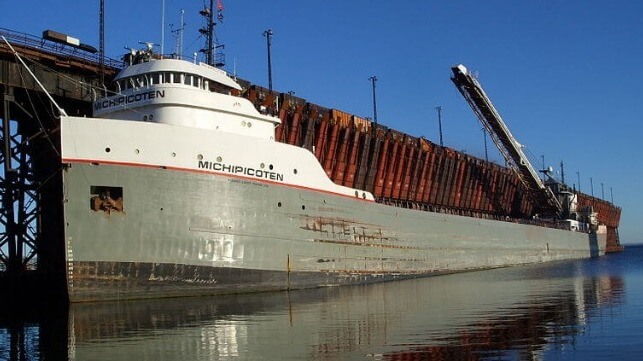Hull Stress or Steel Fatigue Suspected After Laker Takes on Water

Investigators examining the 72-year-old Great Lakes bulker Michipicoten now suspect the vessel suffered steel fatigue or a form of hull stress that caused the flooding incident on Saturday, June 8. Initially, reports were that the vessel had hit an underwater object while underway on Lake Superior. The bulker was able to make it to Thunder Bay, Canada under its own power and is now docked at the Keefer Terminal.
Speaking on Canada’s TBNewswatch, a U.S. Coast Guard spokesperson confirmed that a preliminary investigation has found a “major hull breach.” Divers surveying the vessel at the dock in Thunder Bay, Canada on Monday reported that they had found a crack in the hull measuring approximately 13 feet. The crack was consistent with reports from the crew aboard that they heard a “loud bang” while the vessel was in deep water Saturday morning and then discovered the flooding.
The crack is reported to be “from the turn of the bilge, where the side shell turns to the bottom plate,” USCG spokesperson Lorne Thomas told TBnewswatch.
The Coast Guard has confirmed there were no fixed objects in the area where the bang and flooding began contributing to the belief that it was a failure not due to striking an object. They said during the investigation they would be looking at when the vessel had transited shallower water and confined channels. They would like to determine if it had bumped something or if it had previously grounded. The Coast Guard has not ruled out a collision but says the evidence so far points toward fatigue or a structural fracture.
Crewmembers told the Coast Guard team that there was a “serious amount of flooding coming in,” Saturday morning when they made the distress call. The Coast Guard said the captain and crew of the Michipicoten “did a remarkable job stabilizing the ship.” The bilge pump system was able to reduce the water and help the vessel to decrease its list from 15 to 5 degrees.
Firsthand accounts posted online talked of a harrowing experience with crewmembers quite fearful as the water started rushing into the vessel. Although the crew was able to stabilize the vessel, the U.S. Coast Guard made the decision at midday to remove 11 of the 22 crewmembers for safety, with another laker the Edwin H. Gott providing a lee, blocking some of the waves, while the crewmembers transferred to a Isle Royal Park Service vessel.
Bult in 1952 by Bethlehem Steel at Sparrows Point, Maryland the vessel originally known as the Elton Hoyt II was 626 feet in length overall. It had coal-fired boilers for a steam turbine engine. The ship has undergone several major reconstructions including in 1957 it was lengthened to 683 feet and in 1980 converted to a self-loader. Originally an American ship, she was sold in 2003 to the Canadian company Lower Lakes Towing and in 2010 was repowered with diesel engines.
The US Coast Guard says a more thorough assessment requires drydocking the vessel which will not happen until it is unloaded. Because the incident occurred in U.S. waters, the USCG will remain involved with the investigation. Canada’s Transportation Safety Board is collecting information to determine if they should also become involved. Canadian Broadcasting Corporation (CBC) reports the TSB would investigate if it would provide new safety lessons that advance transportation safety. There might also be a joint investigation between the U.S. and Canada.

that matters most
Get the latest maritime news delivered to your inbox daily.
